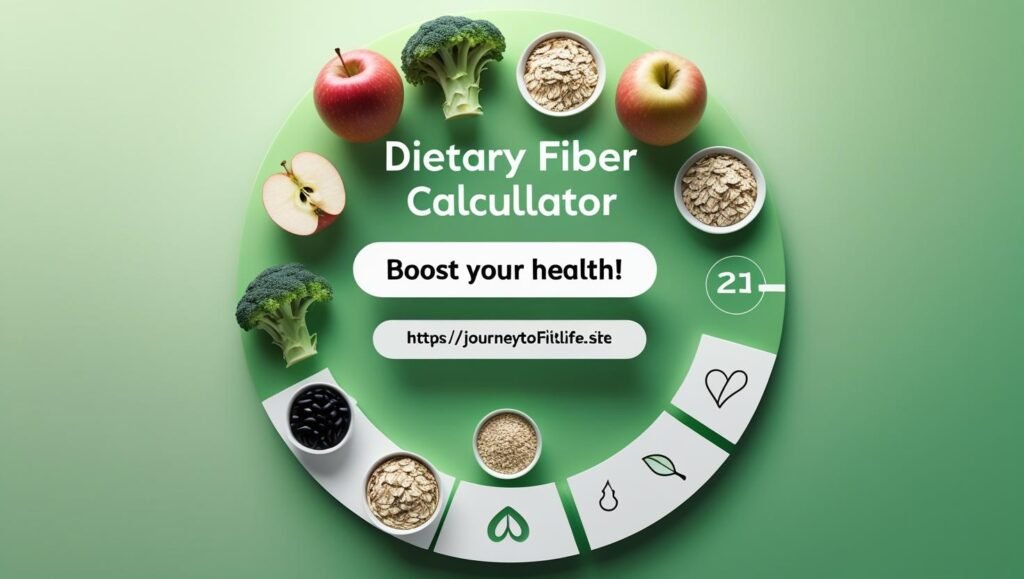
Calculate Your Daily Fiber Needs
The Ultimate Guide to Dietary Fiber: Your Path to Better Health
Fiber is an essential yet often overlooked component of a healthy diet. Unlike other nutrients, fiber passes through your digestive system largely intact, providing numerous health benefits along the way. In this comprehensive guide, we’ll explore what fiber is, why it’s crucial for your health, and how to incorporate more of it into your daily meals.
What is Dietary Fiber?
Dietary fiber, also known as roughage, consists of the parts of plant foods that your body can’t digest or absorb. Unlike fats, proteins, and carbohydrates, fiber isn’t broken down into digestible units. Instead, it passes relatively intact through your stomach, small intestine, and colon before leaving your body.
The Two Types of Fiber
Soluble Fiber
Dissolves in water to form a gel-like substance. It helps lower blood cholesterol and glucose levels.
Found in: Oats, peas, beans, apples, citrus fruits, carrots, barley
Insoluble Fiber
Promotes the movement of material through your digestive system and increases stool bulk.
Found in: Whole wheat flour, wheat bran, nuts, beans, vegetables like cauliflower and green beans
Health Benefits of Fiber
Digestive Health
Fiber normalizes bowel movements by bulking up stools and making them easier to pass. This helps prevent both constipation and diarrhea. As discussed in our 7-day healthy meal plan, fiber-rich foods should be a staple in your diet.
Weight Management
High-fiber foods tend to be more filling, helping you stay satisfied with fewer calories. This can aid in weight loss and maintenance. Fiber also slows digestion, providing a steady release of energy.
Heart Health
Soluble fiber helps lower total and LDL (bad) cholesterol levels, reducing the risk of heart disease. It also helps control blood pressure and inflammation. Check our guide on best foods for fat loss that includes heart-healthy options.
Blood Sugar Control
Fiber, especially soluble fiber, can slow the absorption of sugar, helping to improve blood sugar levels. This is particularly important for people with diabetes or those following a keto diet or carb cycling approach.
How Much Fiber Do You Need?
The recommended daily fiber intake varies by age and gender. Generally, health authorities recommend:
| Age Group | Men | Women |
|---|---|---|
| 19-50 years | 38 grams | 25 grams |
| 51+ years | 30 grams | 21 grams |
| Pregnant | – | 28 grams |
| Breastfeeding | – | 29 grams |
Unfortunately, most people don’t consume enough fiber. The average American gets only about 15 grams per day, far below the recommended amounts. Use our calculator above to determine your personal fiber needs based on your specific circumstances.
Important: Increase your fiber intake gradually over several weeks to allow your digestive system to adjust. Sudden increases can cause bloating, gas, and discomfort. Also, drink plenty of water as fiber works best when it absorbs water.
Top Fiber-Rich Foods
Legumes
Split peas, lentils, black beans, lima beans
Berries
Raspberries, blackberries, strawberries
Whole Grains
Barley, quinoa, oatmeal, brown rice
Nuts & Seeds
Chia seeds, flaxseeds, almonds
Vegetables
Artichokes, broccoli, brussels sprouts
Fruits
Pears, apples, bananas (with skin)
Tips for Increasing Your Fiber Intake
- Start your day with fiber: Choose a high-fiber breakfast cereal (5+ grams per serving) or add berries, nuts, or seeds to your morning yogurt or oatmeal.
- Switch to whole grains: Replace white bread, pasta, and rice with whole grain versions. Look for “whole” as the first ingredient on labels.
- Snack on fruits and vegetables: Keep washed and cut vegetables and fruits ready for quick snacks. As our meal prep guide suggests, preparation is key to healthy eating.
- Add legumes to your meals: Incorporate beans, peas, or lentils into soups, salads, and main dishes. They’re excellent sources of both soluble and insoluble fiber.
- Choose high-fiber alternatives: Opt for brown rice instead of white, whole-grain bread instead of white bread, and whole fruits instead of juice.
- Add seeds: Sprinkle chia, flax, or hemp seeds on yogurt, salads, or smoothies for a fiber boost.
- Hydrate adequately: Drink plenty of water as you increase fiber intake. Our hydration calculator can help you determine your water needs.
Fiber and Special Diets
Keto Diet
While the ketogenic diet restricts carbohydrates, it’s still important to get enough fiber. Focus on low-carb, high-fiber foods like avocados, nuts, seeds, and non-starchy vegetables.
Vegan/Vegetarian Diet
Plant-based diets are naturally high in fiber. However, it’s still important to focus on whole foods rather than processed vegan products. Our vegan diet guide provides more information.
Intermittent Fasting
When practicing intermittent fasting, make sure to include fiber-rich foods during your eating window to support digestive health and help you feel fuller longer.
Low-FODMAP Diet
For those with IBS following a low-FODMAP diet, focus on low-FODMAP fiber sources like rice bran, oats, quinoa, oranges, and strawberries.
Fiber Supplements: When Are They Necessary?
While it’s best to get fiber from whole foods, supplements can help bridge the gap if you’re struggling to meet your daily requirements. Common fiber supplements include:
- Psyllium: Forms a gel in the intestines that helps with both constipation and diarrhea
- Methylcellulose: A synthetic fiber that doesn’t ferment in the gut (causing less gas)
- Inulin: A prebiotic fiber that feeds beneficial gut bacteria
- Wheat dextrin: A soluble fiber that dissolves completely in water
Consult a healthcare provider before starting any supplement regimen, especially if you have existing digestive conditions. As discussed in our article on evaluating supplements, not all products are created equal.
Fiber and Exercise: The Perfect Combination
Combining adequate fiber intake with regular physical activity creates a powerful synergy for overall health. While fiber supports digestive health and helps manage weight, exercise improves cardiovascular health, builds muscle, and enhances mood. Together, they form the cornerstone of a healthy lifestyle.
For those new to exercise, our beginner exercise guide and 15-minute workout plan are excellent starting points. Remember that proper nutrition, including adequate fiber, supports your fitness goals by providing sustained energy and aiding recovery.
Conclusion: Making Fiber a Priority
Increasing your fiber intake is one of the simplest yet most effective dietary changes you can make for better health. From improved digestion and weight management to reduced risk of chronic diseases, the benefits are substantial and well-documented.
Use our Fiber Intake Calculator to determine your personal needs, then gradually incorporate more fiber-rich foods into your diet. Remember to increase your water intake as you add more fiber, and give your body time to adjust to the changes.
For a comprehensive approach to health and fitness, explore our other calculators and resources, including our Calorie Calculator, Macro Calculator, and BMI Calculator.
